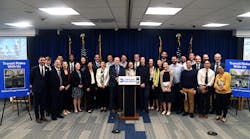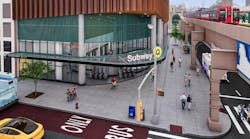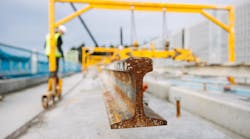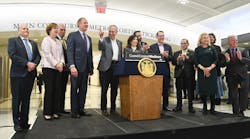OP-ED: What's missing from MTA's 2025 - 2044 Twenty Year Capital Plan
Some key information is missing from the New York Metropolitan Transportation Authority (MTA) 2025 - 2044 Twenty Year Capital Needs Assessment Plan. After spending two years developing this plan, I give them credit for the release close to the promised Oct. 1, 2023 date. It appears the estimated costs for more than 20 potential enhancement and expansion projects would be about $85 billion based upon 2027 construction cost estimates. The problem is this would be the third year of a 20-year horizon. Virtually all of these projects would need several years or more beyond 2027 to complete any environmental review, design and engineering. Many might also involve property easements, business relocation, land acquisition and various utility relocation before being able to proceed into construction years later. These estimated costs based upon 2027 will easily grow by billions more over the 20-year time period.
There is also inflation, periodic economic recessions, potential supply chain issues, increasing fuel prices, rising material costs and labor shortages in specialized trades to deal with. They can result in cost estimates going up over coming years, prior to award of any construction contracts for these potential projects.
There is no explanation for potential New York City, New York state or Washington, D.C., funding sources to pay for these projects. There is no explanation as to which projects are or will proceed following the National Environmental Policy Act to preserve the ability to obtain federal funding.
The Federal Transit Administration's (FTA) Capital Investment Grant (CIG) national competitive discretionary Core Capacity/System Expansion program is an obvious source of funding for most of these projects. For those proposed projects whose costs are in the several hundred million dollar range, various FTA formula and other national discretionary competitive grant programs are possible funding sources. Some of the larger ones include Section 5307 Urban Formula, Section 5337 State of Good Repair and Section 5339 Bus and Bus Facilities. A project funding might be bridged over several years worth of annual federal grant cycles. The MTA received close to $1.8 billion in 2023. This will grow even more in coming years.
There is no timetable as to which of the four 2025-2029, 2030-2034, 2035-2039 or 2040-2044 upcoming Five Year Capital Program would include any of these individual projects. I have been following the history of MTA's capital program since the early 1980s. This includes previous Twenty Year Capital Plans, Five Year Capital Programs, along with Annual FTA Program of Projects and grant applications for funding. It is disappointing to have found cost creep over time for some of the projects under consideration. The following are worthy of discussion:
- Reopening the Long Island Rail Road (LIRR) Port Washington branch Elmhurst Queens Station closed in 1982 project budgeted at $40 million has grown to $210 million. The MTA originally allocated $40 million, which was sufficient funding at the time, to pay for this work under the MTA $32 billion 2014 - 2019 Capital Program. In 2016, $4 million was to be spent for planning, environmental review, design and engineering. This would have been followed by construction in 2018 for $36 million. The new station was anticipated to be opened by the end of 2019. In 2017, the MTA added $3 billion ($1.95 billion for LIRR Main Line Third Track and $700 million for Second Avenue Subway Phase 2) to the $29 billion 2015 - 2019 Five Year Capital Program Plan, bringing it up to $32 billion. Buried in this plan amendment was reprogramming $37 million originally allocated to support construction of the new Elmhurst LIRR Station to pay for other projects. Only $3 million remained for preliminary design and environmental review. Restoration of $37 million to support final design, engineering and construction was suppose to have been included within the $51 billion MTA 2020 - 2024 Five Year Capital Plan. This never happened.
- Suffolk County Port Jefferson LIRR branch electrification project has grown from $2 to $3.1 billion. The idea of electrification has been periodically advocated since the 1960s (when the cost would have been well under $1 billion) by generations of elected officials with no success. In 1970, electrification was extended from Mineola to Huntington. In the 1980s, discussions took place between the MTA, LIRR, Suffolk County and elected officials over which of two diesel territory LIRR branches should be electrified first. The Ronkonkoma branch was selected over the Port Jefferson branch
- Second Avenue Subway Phase 2 has grown from $5.5 billion to $7.5 billion. In April 2019, the MTA Office of Capital Construction President Janno Lieber claimed the MTA could save between $500 million to a $1 billion in costs for the proposed Second Avenue Subway Phase 2. This would have reduced the overall tab down to almost $5 billion. Promised cost savings were based upon reduction in excavation for the 125th Street Station and building the 116th Street Station in space no longer needed for other project work. In February 2022, the MTA came clean and admitted the cost increased to $6.9 billion. Once again, in 2023 the MTA estimated cost grew to $7.5 billion. The March 2023 FTA Annual Report on Funding Recommendations for Federal Fiscal Year 2024 estimates the project cost to be $7.69 billion.
- Staten Island North Shore bus rapid transit (BRT) has grown from $600 million to $1.3 billion.
- Staten Island West Shore BRT has grown from $1.5 billion to $1.8 billion.
- The proposed new LIRR Sunnyside Yard Queens Station has grown from $400 million to $490 million for just the LIRR portion, Double the price when adding the MTA Metro-North Rail Road share to almost $1 billion. In 1998, as part of the proposed MTA LIRR Eastside Access project, construction of a passenger station was considered for Sunnyside Yard. This station was not included as part of the FTA $6.3 billion (federal share - $2.6 billion) CIG Full Funding Grant Agreement (FFGA) to MTA for Eastside Access to Grand Central Terminal in 2006.
- The missing Manhattan Hudson Yard #7 Flushing Intermediate Station has grown from $500 million in 2007 as part of the original $2.4 billion New York City (NYC) Transit #7 Hudson Yard subway extension from Times Square station to the new 34th Street Hudson Yards station project to $1.9 billion. The original Hudson Yards project cost was $2.1 billion and ended up at $2.4 billion, not counting the intermediate subway station that had to be dropped from the original scope of work. Neither NYC Transit, nor the MTA, could find $500 million to cover the proposed new intermediate subway station to be built at 10th Ave. and 41st St. This station was part of the original project scope. One trick used by transit managers to complete any project within budget, is to drop a portion of the original work. This saves the necessary dollars, which were not available to deliver 100 percent of what was originally promised. Deletion of this second station kept the project cost at $2.4 billion rather than $2.9 billion.
- The NYC Transit West subway line extension from downtown Manhattan to Red Hook, Brooklyn has grown from $3 billion to $7.6 billion.
Not included for consideration was former NYC Mayor Bill de Blasio's Brooklyn-Queens Street Car Connector at a cost of $2.8 billion, reopening the LIRR Atlantic Branch Woodhaven Station at a cost of $40 million, closed in 1978, and reopening the Flushing Intermodal Bus Terminal at a cost of $100 million, closed in 1954.
These three potential capital improvement projects were not included with 20 others comparatively evaluated for consideration on a level-playing field for future Five Year Capital Programs. This deliberate omission means the MTA has no interest in advancement for any of these three projects. I have never been a supporter of the Brooklyn Queens Street Car Connector. I have supported reopening the Atlantic Branch Woodhaven LIRR Station and Flushing Queens Intermodal Bus Terminal. It is disappointing the MTA did not believe that these two projects were worthy of consideration.
The MTA still needs to meet promised previous commitments for transparency. This includes cost, budget, funding source and milestones as part of future development of capital projects and programs. The devil is in the details, which is still missing.
The number one priority for the MTA should always be to reach and maintain a state of good repair. This includes each MTA operating agency, including NYC Transit subway and bus, Staten Island Railway, Manhattan Bronx Surface Operating bus, MTA bus (the former seven NYC private franchised bus operators absorbed in 2005/2006), LIRR and Metro North Railroads. Categories for each agency include such assets as:
- Existing bus, subway and commuter rail fleet
- Stations and elevators to meet Americans with Disabilities Act (ADA) standards
- Escalators
- Track, including switches, signals and interlockings
- Communications
- Line structures, including painting, protective netting on elevated structures and bridges
- Line equipment, including tunnel lighting, pump rooms and emergency exits
- Traction power
- Power substations
- Maintenance shops
- Yards
- Employee facilities
- Supervisory vehicles
Funding for $7.69 billion Second Avenue Subway Phase 2 and $5.5 billion Brooklyn/Queens Light Rail Connector would be better spent on first reaching a state of good repair, safety, bringing most NYC subway stations into compliance with the ADA and having open clean safe bathrooms, including longer hours for all MTA operating agencies, especially 472 NYC Transit subway stations. Any independent survey of riders would tell you an overwhelming majority of 5 million plus pre-COVID 19 customers would prefer on time, safe, reliable services at a fair price before system expansion.

Larry Penner
Larry Penner is a transportation advocate, historian and writer who previously served as a former director for the Federal Transit Administration Region 2 New York Office of Operations and Program Management. This included the development, review, approval and oversight for billions in capital projects and programs for New Jersey Transit, New York Metropolitan Transportation Authority, NYC Transit bus, subway and Staten Island Railway, Long Island and Metro North railroads, MTA Bus, NYCDOT Staten Island Ferry along with 30 other transit agencies in New York and New Jersey.





